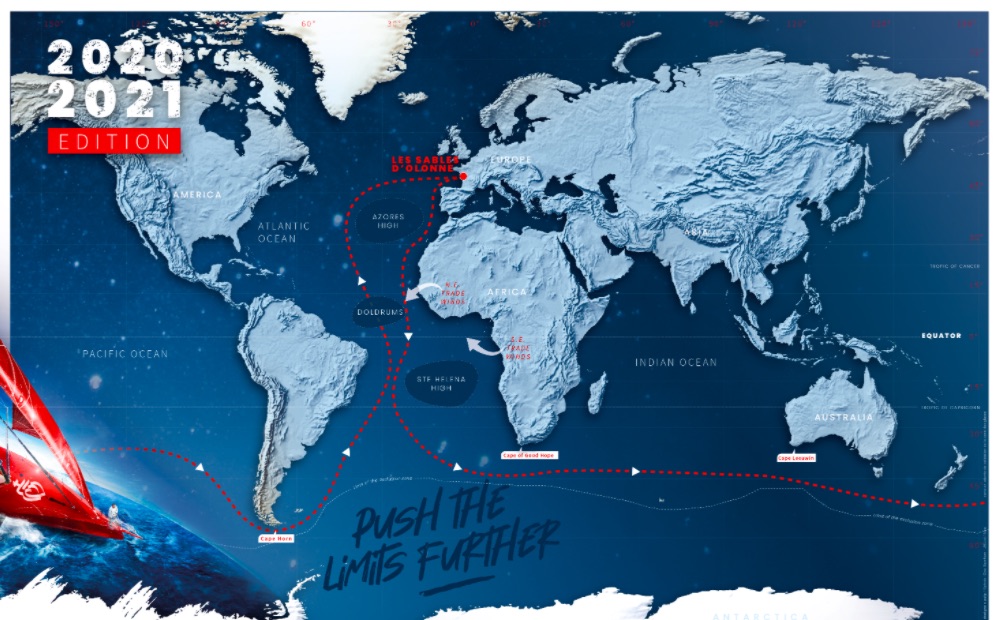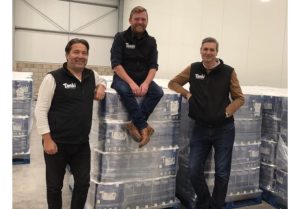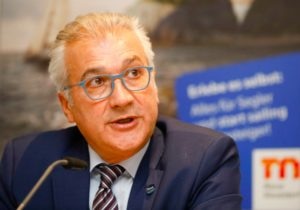Alex Thomson heralds Gosport as ‘blessed’ town, as ice exclusion zones pinpointed
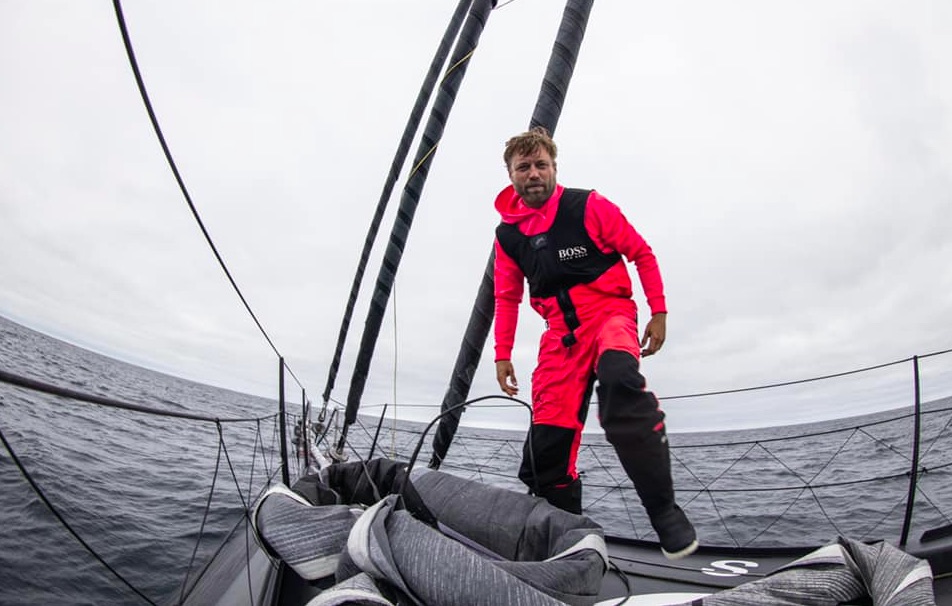
Alex Thomson (Hugo Boss Vendée Globe competitor) has heralded his hometown of Gosport as ‘blessed’. He says the maritime town has all the suppliers he needs.
“They know what we need – the details – it’s important,” Thomson says. “We need to keep that Gosport skill, and to keep campaigns running out of there.” It’s where Thomson has spent his Vendée Globe lockdown, prior to the race, although he’s now back in Sables d’Olonne where the team’s still crunching data.
“We’re running through data learning stuff from the last 20,000 miles,” Thomson says. “We’ve run the routes for the last 40 years – with weather.” He’s calculated that the minimum time the current Hugo Boss could circumnavigate in any of those years is a sparkling 59 days, while the longest is 90 days. But, as Thomson says: “It’s a big spread and hard to predict.”
When they’re not engaged in the maths, Thomson says his team are ‘beating’ him into shape.
“We made a deal to allow me to have a beer after training but I’m being disciplined all the time. I’ve stopped myself from eating pork pies and done a lot of sailing this year. I’m feeling in good shape. I’m five kilos lighter, about my last Vendée Globe finishing weight. But I have more food on board this time. My aim is not to lose any weight. We’ve worked hard on food to get me stuff I want to eat and get motivated to eat.
“It’s been a long journey, disrupted by Covid, but we’ve stuck to the plan and achieved everything we wanted to achieve. It feels good.
“People ask me what it’s like [to compete]. After the last one I said ‘I live in a cave’.”
That’s still the same for this race, as Thomson admits he doesn’t feel safe going forward when travelling at 40 knots. But, the big difference this time is that he can see the trim of the sails from portholes in his cockpit, which he is delighted about. Check out the video below which gives a rundown of the complex systems inside the cockpit – with 3km of rope and 46 lines.
As well as prepping for his own race, Thomson has been offering guidance to Ari Huusela, Ocean Racing. Huusela says Thomson has pushed home the need to create value for the sponsors.
“The main call is sponsors are happy and will continue with us. So, we must make our sport well known and interesting for sponsors,” says Huusela.
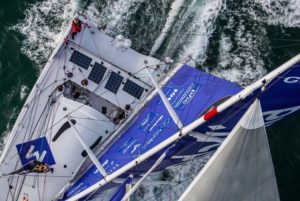
Pip Hare, Medallia, says the last week has been ‘a bit weird’.
She says: “Having been hands-on for the beginning and being hands-off for the last week has been a struggle.
“Right now, I’m nervous as hell. I was so focused on getting to start and now I’m transitioning into getting to the finish. I’m very aware of all the variables that could happen on the way. We’re doing everything we can to mitigate every problem we might have with the boat, but stuff happens. I definitely feel the weight of the start coming up.
“The work we’ve been able to do in the last three months is incredible, we’ve turbo-charged the boat. I was out training in big breezes a lot. It feels good, it feels solid and it feels like the right boat for me.”
Hare says that it’s a ‘phenomenal thing’ that there are six female skippers taking part.
“I hope that in 2022 there will be 12 or more. Traditionally it’s very difficult for women to take part in the ocean racing but more and more women are finding their feet in the sport,” Hare says. “I hope that by other women seeing the six of us take our places on the start line, under equal terms as everyone else, they will feel they belong in the sport and will take steps forward.”
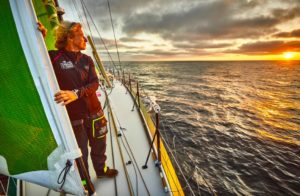
Miranda Merron is one of the six. She’s “looking forward to last media and support boat turning back as that’s when the race really starts.”
Merron says being at sea is “one of the last places of complete freedom. We’ve not managed to wreck it completely yet. Extraordinary to spend time in such a pristine environment.”
Meanwhile, race organisers have set the ice exclusion zone which means this iteration of the Vendée Globe is 24,296 nautical miles, or 44,996kms (the theoretical course distance in 2016-17 was 24,394 miles).
In collaboration with CLS, the race partners who monitor the ice zones and movement, the race directors have now marked out the exclusion zone using 72 GPS points. The 33 solo racers must stay north of this limit line at all times.
“For the past several months, we have been working with CLS (Collecte Localization Satellites) to monitor the movement of ice in the Antarctic zone, in the Indian Ocean as in the Pacific Ocean. These satellite images are monitored and processed at CLS Brest by a radar specialist. We established an initial zone on October 1st and, last Wednesday, we refined the positioning and published the Start Version of the Antarctic Exclusion Zone,” says Jacques Caraës, the Vendée Globe race director.
This year, the Antarctic Exclusion Zone has been lowered by around 1°. But GPS points have moved north by around 1 to 2° in the area west of Georgia. The proposed route was initially 24,385 nautical miles as at October 1st and on the start day it will be 24,296 miles. Obviously, the further south the fleet races the shorter the route.
The position of the ice fields are not the only determinants in positioning the exclusion zone. The Australian Maritime Rescue Coordination Centre (MRCC) and the Australian Maritime Safety Authority (AMSA) request four points which mark their safe rescue limit from their centres, of around 1,000 nautical miles. This is agreed between the Australian authorities and the Race Direction in particular following the rescue of injured Yann Eliès in 2008. These four points are located at latitude 46 ° 00 South and run from 105 to 120° East longitude.
The zone can be updated during the race.
“We update the exclusion zone during the race, watching to see if the ice moves north. We take pictures before the first ones approach the Kerguelen and, if CLS detects an iceberg or suspects its presence, we issue an Ice Report to the fleet. And we can move the GPS points within a defined framework, based on the position of the leader, and which respects their navigation strategy,” says Caraës.
There are also key traffic separation scheme zones which are in place to keep the fleet away from shipping traffic schemes. There are GPS points for prohibited zones at Cape Finisterre, Cape Roca (the westernmost point of Portugal), Cape St Vincente (southwesternmost point of Portugal), Mauritania, and to the east and west of the Canaries as well as Ushant TSS and Scilly Ouest.
